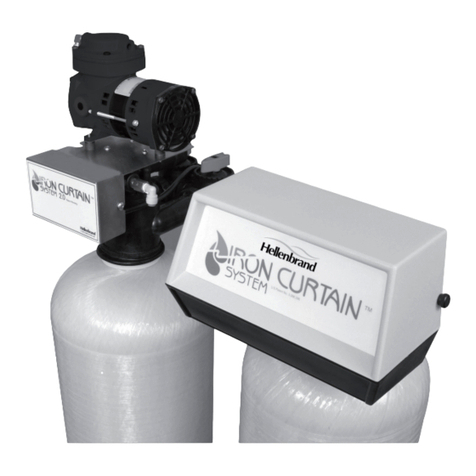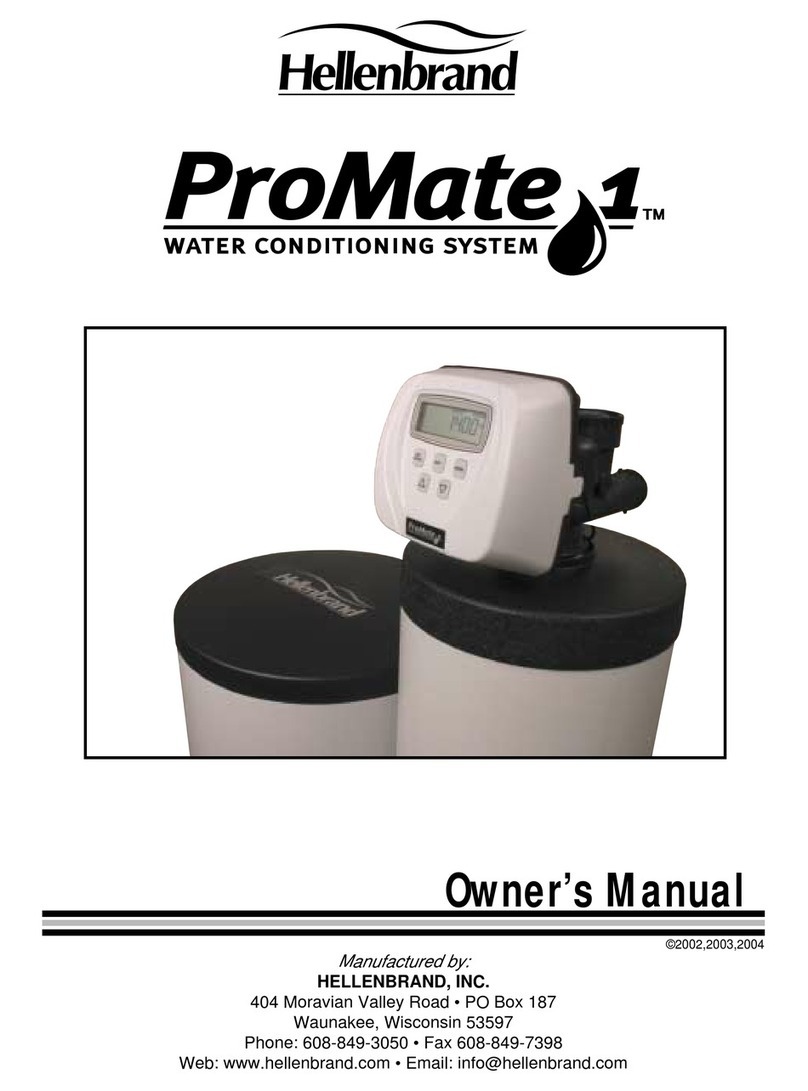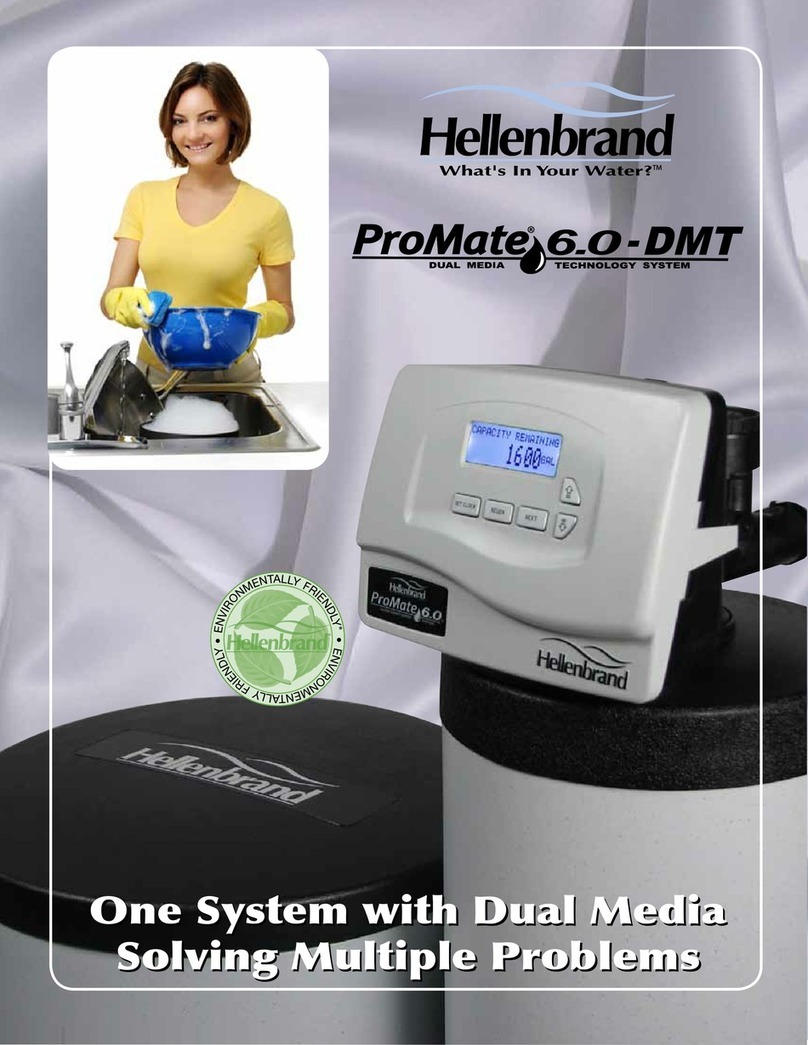
4
Operating Conditions
The original Iron Curtain System has been validated by the
WQA under their S-200 Filter Standard for the reduction/
removal of iron, manganese, and/or hydrogen sulfide. The
concentration limits listed below reflect the maximum individual
limit that each contaminant was tested for separately without
any interference of other contaminants in the influent water.
In reality, these contaminants may be present in combination
which may limit the filter’s ability to remove these contami-
nants in higher concentrations. In some cases, individual
sellers of this equipment have had success removing higher
concentrations of contaminants—iron, for example—above
the limitations we have listed. If you are considering the
installation of this system for the reduction/removal of iron,
manganese and/or hydrogen sulfide levels that are above
operating conditions listed below, we recommend that you con-
sult your dealer for proper application. Installation of this
system under these circumstances may void part(s) and/or
all of the system warranty.
pH — The pH level of the influent water must be 7.0 or higher
for iron oxidation reaction to proceed per the engineering
specifications.*
Iron — This system is rated for a maximum of 10 ppm of
ferrous (clear water) and/or ferric (red water) iron.*
Iron Bacter a — If iron bacteria are present; more frequent
service may result, life of the Iron Curtain system may be
limited and the system may be unable to properly remove
iron. By properly controll ng the ron bacter a w th chlo-
r ne or other approved methods for bacter al reduct on,
the Iron Curta n System w ll funct on properly. One opt on
to control ron bacter a w th n the Iron Curta n s chlor ne
nject on dur ng the regenerat on cycle. In some n-
stances, cont nuous chlor nat on of the water supply may
be needed.
Hydrogen Sulf de — Sometimes referred to as "rotten egg"
odor. This system is rated for a maximum of 10 ppm
hydrogen sulfide. Hydrogen sulfide levels vary depending on
barometric pressure.*
Manganese — Limit 2.0 ppm; amounts present over 2.0 ppm
may gradually prevent iron removal. Note: For optimum
manganese reduction, pH should be greater than 8.5.*
Organ c Matter (Tann ns) – The presence of organic matter
such as tannins will prevent the oxidation process of converting
the dissolved element, such as iron or manganese, to a
nonsoluble precipitate or solid substance. In other words,
organics can tie up the iron preventing filtration. The presence
of organ cs such as tann ns above 0.5 ppm vo ds any
cla ms for th s system to perform as stated above. In some
appl cat ons, tann n levels below 0.5 ppm or the presence of
other organ cs may h nder the operat on of th s system.*
Chlor ne — The presence of chlorine in the raw water supply
ahead of this system should be limited to a maximum of 1.0 ppm
residual and preferably 0.5 ppm or less when fed continuously.
Total D ssolved Sol ds (TDS) — While TDS does not
directly affect iron removal, it is a good indicator of potential
interference. Most waters have TDS less than 500 and gener-
ally present no problems to iron reduction. If any ion becomes
excessive, it may cause failure of iron removal. A TDS more
than 750 ppm vo ds any cla ms for th s system to perform as
stated above.*
Pre-Installation Check List
Water Pressure: A minimum of 0 psi at a predetermined
continuous flow rate is required to backwash the filter properly,
with a maximum of 70 psi to be used.*
Actual Influent Flow Rate: (Water available from well pump,
service inlet, etc.) The actual flow rate must exceed the
backwash rate for the model of filter selected at a minimum of
0 psi for the entire length of the backwash cycle. See actual
backwash rates in the Specifications section on page 6.
Electr cal Requ rements for F lter Control: A continuous
110 volts is required to cycle the controls and aeration pump.
Make certain the electrical supply is always on and cannot be
turned off with another switch.
Ex st ng Plumb ng: The condition of the existing plumbing
should be free from lime and iron build-up. Piping that is heavily
built-up with lime and/or iron should be replaced.
Equ pment Locat on: See Figure 1,on page 7.
Locat on of Aerat on and F lter Tank: See Figures 1 on page 7.
These two tanks should be installed after the pressure tank and
as close to each other as practical. If you want to filter outside
hosebibs, be sure the filter system is properly sized to handle
the flow rates required for extended periods of time, in addition
to the normal household demand.
Dra n L nes: All filter system drain lines must be a m n mum
of 3/4" or equal to the size of the drain line connection at the
control valve or larger. Avoid overhead drain lines when
possible. If used, overhead drain lines are not to exceed a
height of five feet above the control valve and should be no
more than fifty feet in length.
Check Valve: On applications where there is a non-filtered
demand for water such as joint wells (where the filter system
is only installed in one of two or more homes), outside
hosebibs, farms with outbuildings, yard hydrants, etc. a spring
loaded check valve is provided and must be installed ahead
of the aeration tank. See Figures 1, on page 7. Install the
check valve in a vertical upflow position with a minimum 6"
water column above the check valve. This prevents air from
escaping past the check valve. If the check valve is installed
in a horizontal position, and there is a simultaneous demand
for both non-filtered and filtered water, the air head in the
aeration tank may escape backwards past the check valve
into the non-filtered water line.
By-Pass Valves: Always provide for a bypass on the filter
system. It is recommended that a bypass be placed on both
the aeration tank and the filter tank.
F ltered Water: Normally, filtered water is furnished to all
household lines; however, outside faucets are typically left on
raw water. If filtered water is provided to outside faucets, the
filter system must be sized accordingly.
Caut on: The water pressure is not to exceed 70 p.s.i.; water
temperature is not to exceed 110° F; filter system cannot be
subject to freezing conditions; filter system cannot be subject
to a negative pressure or vacuum. On installations where there
is the possibility of a negative pressure or vacuum, a vacuum
breaker or check valve must be installed at the inlet of the
conditioner. For example, if the water service is interrupted due
to a water pipe break, well pump being serviced, etc., a back
siphon could occur causing a vacuum or negative pressure on
the filtration equipment.
*For appl cat on parameters outs de the spec f ed operat on cond t ons or add t onal nformat on regard ng the l sted tems,
contact your dealer.
































